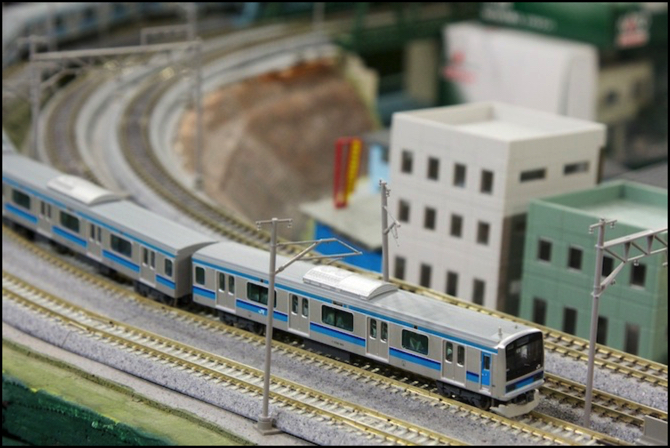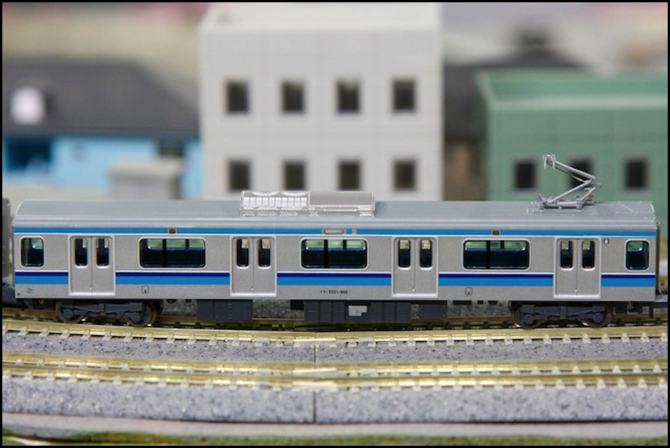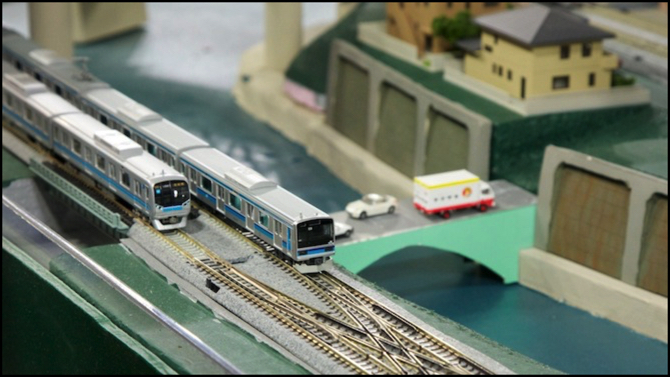Micro Ace E231-800
27 December 2011 23:39 Filed in: Model Trains,Review

As any regular reader knows, the JR East E231 is the train the sparked my interest in Japanese trains, and in particular in the commuter trains of Tōkyō. I’m not really clear why myself. Objectively they’re simply boxes engineered to move large numbers of people rapidly. Perhaps it’s the simple functionalism of the design, coupled with the fact that it represents the culmination of fifteen years of re-engineering the commuter train, begun by the Japanese National Railway in the 80’s, and leading through several intermediate designs to one that now numbers over 2,700 cars. The E231 is hardly the end; evolved designs are already out there in the E233 and the prototype E331 (Japanese Wikipedia). But with the E231, JR East reached a point where the design achieved the original goal of “half the cost, half the life”, meaning a reduction in both initial cost and maintenance, at the expense of a reduced lifespan (15 years versus 30).
The E231 has been produced in many variants, but one of the most interesting lacked a model until now, the E231-800. This train, of which only seven 10-car trains were made, was produced to provide run-through service from JR East’s Chūō-Sōbu Line to the Tōkyō Metro Tōzai subway line. These replaced older 301 and 103 series trains dating from the 1960’s. For this use, the standard E231 body was reduced from 2.95m to 2.80m, giving the front a more squared-off appearance. Also, end doors were added to the cabs for in-tunnel emergency exits.
This model is by Micro Ace. It is equipped with Rapido couplers, but compatible with their F0001 black “tight lock” Shibata close couplers. It is compatible with Micro Ace’s lighting sets (G0001 through G0004).

Side view
The level of detail is quite high, with fine printing and molded details extending to silver panels on some of the under-side equipment cabinets (see above). The interior is molded of a dark-blue plastic, and along-the-wall seats with clearly defined individual seatbacks are present in all but the motor car (which has the “floor” level with the bottom of the windows). Exterior details are all pre-applied, although a set of destination sign stickers is included.
The wheels are blackened metal and roll well; in motion the motor is silent, and only the hiss of the rolling wheels is audible. Low-speed operation is good, creeping along at a scale 19 kph (12 mph) reliably. Stopping, however, is abrupt, suggesting that it is not equipped with a flywheel (I haven’t tried to take it apart).
This is a nice train to pair with my recent Greenmax 05 Series Tōzai subway train when I want the Subway line to stand in for one of Tōkyō’s busiest lines (Wikipedia reports that usage peaks at 199% of designed capacity during rush periods, carrying 1.2 million riders per day, still only half the daily ridership of the circular Yamanote line). Like the Chūō-Sōbu Line, the Tōzai line (whose name means East-West) is a major artery from both eastern and western suburbs into the city center.

Tōzai Line trains: 05 Series (left) and E231-800 (right)
Because of its dual commuter/subway role, this is an important model for me, as it will be equally at home on my Commuter and Subway lines, and will be one of the few trains that can reasonably operate across the interconnection in the Riverside station. It will require some kind of wire-in DCC decoders (both of those lines are DCC-only), and will likely be one of my first wire-in commuter train conversions.




